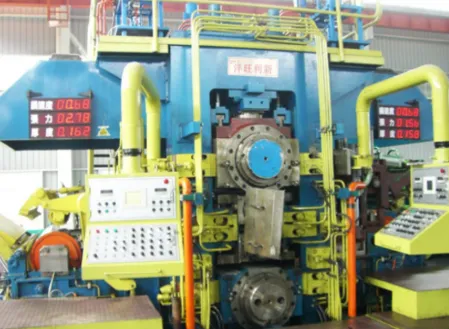
Analysis of Temper Mill Process for Surface Rolling of Construction Steel
The temper mill process is a critical step in the production of high-quality construction steel, ensuring optimal surface finish, mechanical properties, and dimensional accuracy. This process involves light cold rolling of steel sheets or strips to enhance their surface characteristics, improve flatness, and achieve precise thickness tolerances. The high precise temper mill plays a pivotal role in refining the steel's microstructure, eliminating yield point elongation, and enhancing formability.
Construction steel requires superior surface quality to meet stringent industry standards, particularly for applications in structural components, automotive parts, and building frameworks. A high-quality temper rolling mill ensures uniform surface texture, minimizes defects, and enhances the steel's strength without compromising ductility.

The Role of the Temper Mill in Surface Refinement
The primary objective of the temper mill process is to impart a smooth, defect-free surface while improving mechanical properties. Unlike heavy cold rolling, temper rolling involves minimal reduction (typically 0.5% to 5%) to avoid excessive work hardening. A high precise temper mill achieves this by applying controlled pressure, ensuring uniform deformation across the steel strip.
One of the key challenges in construction steel production is the presence of Luders bands, which cause uneven deformation during forming. The temper pass mill effectively eliminates these bands by introducing slight plastic deformation, thereby enhancing the steel's uniformity. Additionally, the soft rolling mill technique is employed for low-carbon steels, where excessive hardening must be avoided to maintain formability.
Key Parameters in the High-Quality Temper Rolling Mill Operation
To achieve optimal results in the temper mill process, several parameters must be carefully controlled:
Rolling Force and Tension – Precise control of rolling force ensures consistent surface texture, while proper tension prevents strip buckling or elongation.
Roll Surface Finish – The rolls in a high precise temper mill must maintain a fine surface finish to avoid imprinting defects onto the steel.
Reduction Rate – A minimal yet uniform reduction is critical to avoid over-hardening while still improving surface quality.
Lubrication and Cooling – Effective lubrication reduces friction, preventing surface scratches, while controlled cooling maintains microstructure stability.
A high-quality temper rolling mill integrates advanced automation systems to monitor these parameters in real-time, ensuring repeatable and defect-free production.
Advancements in Temper Pass Mill Technology
Modern temper pass mill designs incorporate innovative features to enhance efficiency and precision. Some notable advancements include:
Closed-Loop Control Systems – These systems adjust rolling parameters dynamically based on real-time feedback, ensuring consistent output.
Laser-Based Thickness Monitoring – Non-contact sensors measure strip thickness with micron-level accuracy, enabling immediate corrections.
Adaptive Roll Grinding – Rolls are periodically reground using CNC systems to maintain optimal surface finish.
Additionally, the integration of soft rolling mill techniques allows manufacturers to process high-ductility steels without compromising their mechanical properties.
Surface Quality and Defect Prevention in the Temper Mill Process
The surface quality of construction steel is crucial for corrosion resistance, paint adhesion, and weldability. A high precise temper mill minimizes common defects such as:
Roll Marks – Caused by uneven roll wear or improper lubrication.
Scratches and Scuffs – Resulting from improper handling or abrasive contaminants.
Edge Cracks – Due to excessive tension or uneven deformation.
By optimizing rolling speed, tension, and lubrication, a high-quality temper rolling mill ensures a defect-free surface, meeting the stringent requirements of construction applications.
The Future of Temper Mill Technology in Construction Steel Production
The temper mill process remains indispensable in the production of high-performance construction steel. With advancements in high precise temper mill and temper pass mill technology, manufacturers can achieve superior surface quality, enhanced mechanical properties, and improved dimensional accuracy. The adoption of soft rolling mill techniques further expands the range of processable materials, ensuring flexibility in production.
As automation and real-time monitoring systems continue to evolve, the efficiency and precision of the high-quality temper rolling mill will further improve, setting new benchmarks in construction steel manufacturing. Future research should focus on energy-efficient rolling methods and AI-driven process optimization to enhance sustainability and productivity.
By leveraging these innovations, the steel industry can meet the growing demand for high-strength, lightweight, and corrosion-resistant construction materials, reinforcing the critical role of the temper mill in modern metallurgy.
-
YWLX’s 1450mm Six-Hi Reversing Mill Goes Live in BangladeshNewsNov.24,2025
-
Adjusting Roll Gap in 6Hi Reversing Cold Rolling Mill for Thin StripNewsNov.13,2025
-
Quality Control Standards for Automatic Gauge Control in Strip RollingNewsNov.13,2025
-
Effect of Skin Pass Rolling on Metal DuctilityNewsNov.13,2025
-
Key Components of a Modern TempermillNewsNov.13,2025
-
Common Wear Patterns of Work Roll in Tandem Cold Mill OperationsNewsNov.13,2025
-
Revolutionary Skin Pass Rolling Technology for Enhanced Steel QualityNewsNov.04,2025










